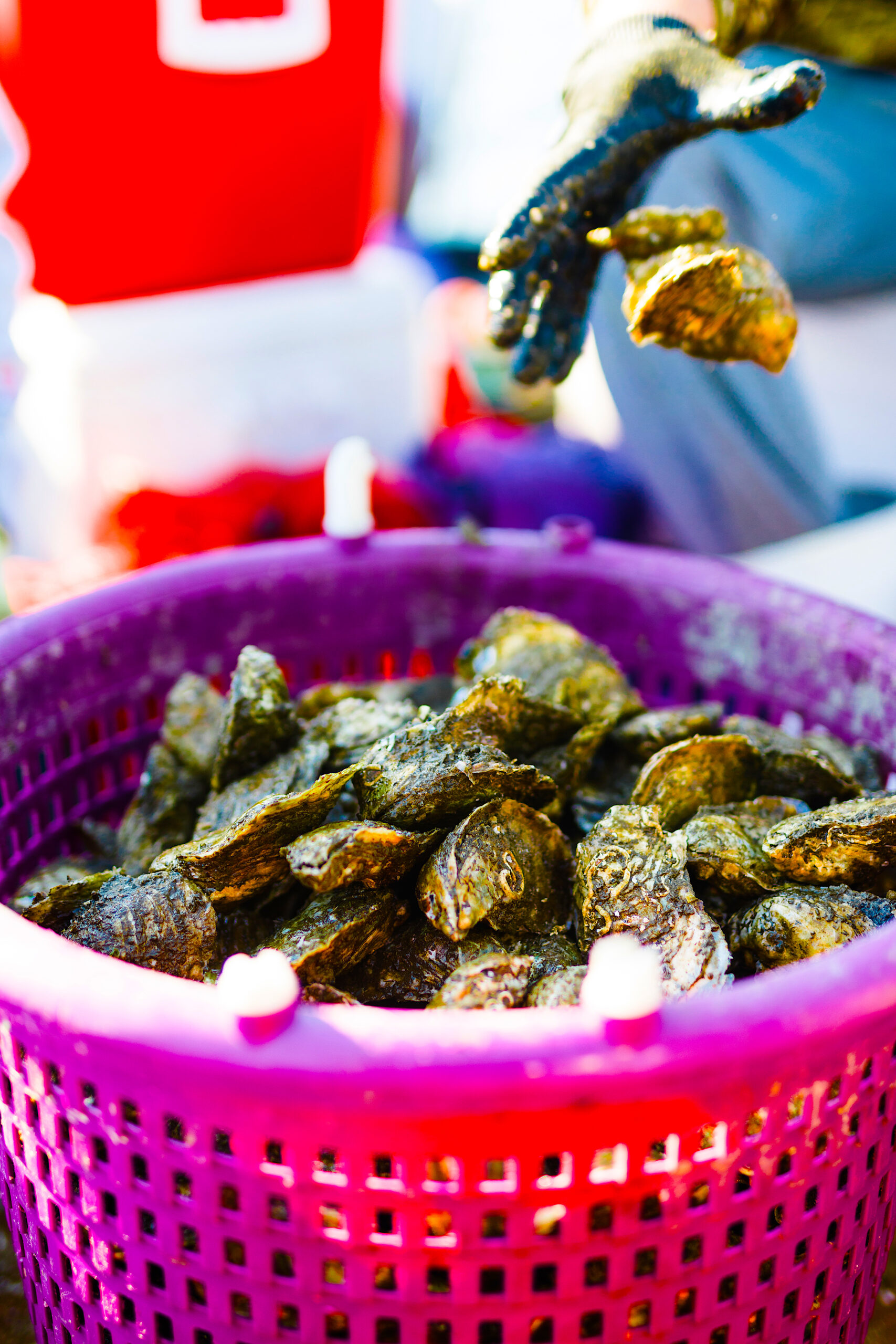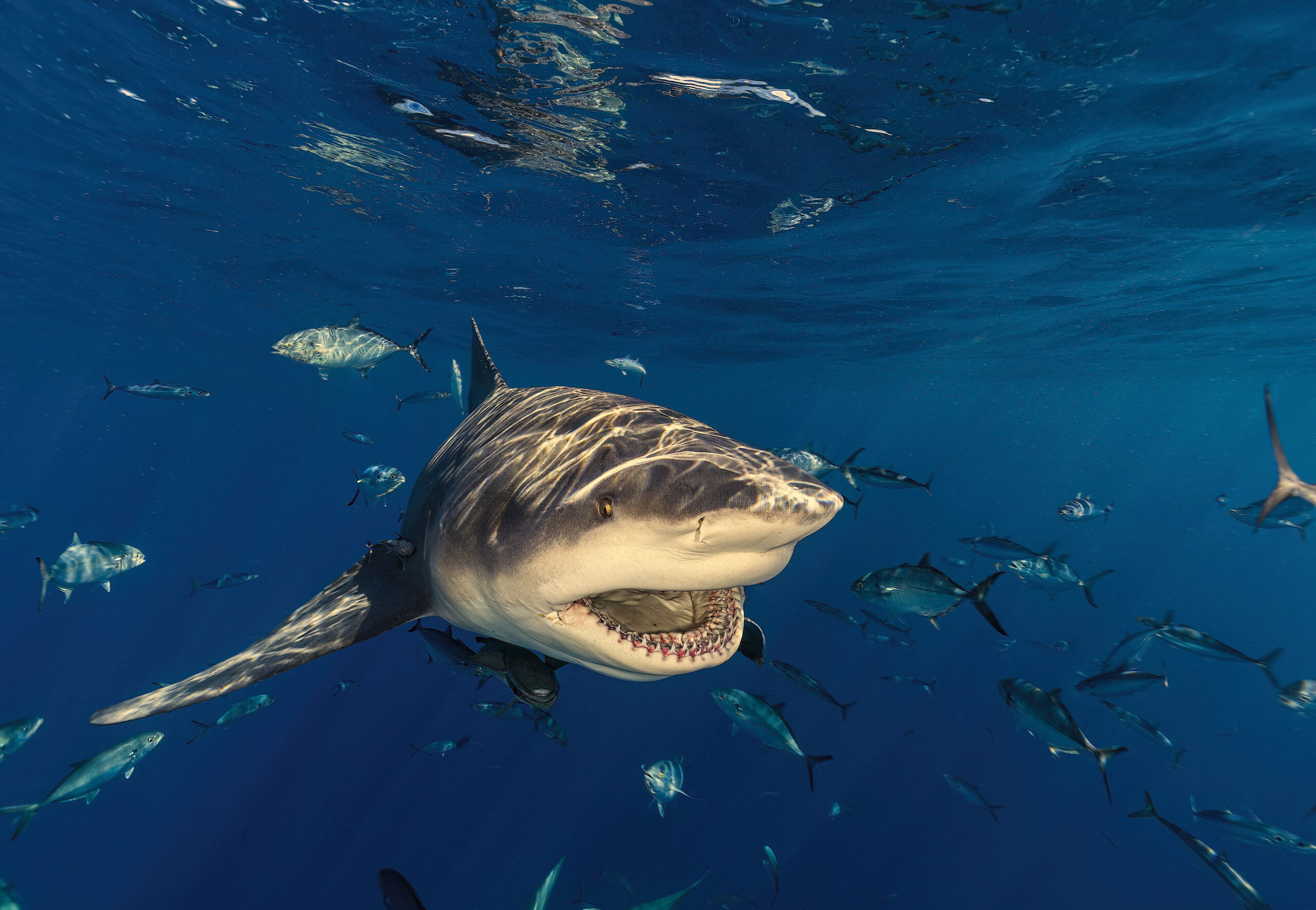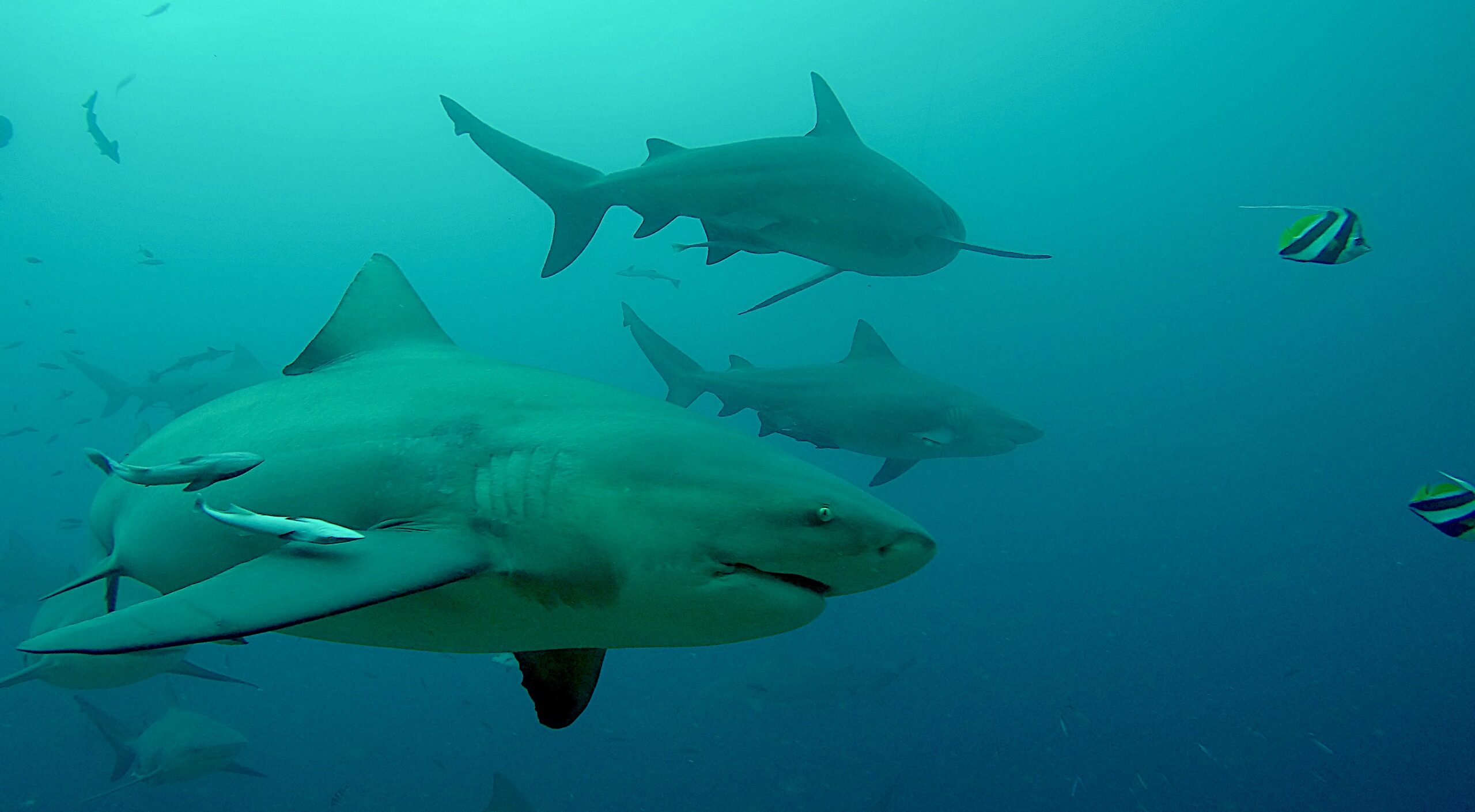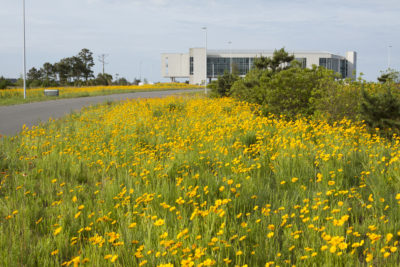Joey Daniels shucks an oyster he just pulled from the Roanoke Sound and pops it into his mouth.
“Twenty-four parts per thousand,” he announces, stating a level of saltiness for the oyster.
Then he tosses the shell back into the water with a flick of his blue-gloved Daniels, the fourth generation of a Wanchese fish house family, is showing a visitor around his oyster lease — a guest who laughs at his bold declaration.

“What? You think I’m kidding?” he demands, with a chuckle.
Daniels, who runs the Bodie Island Oysters aquaculture operation for Wanchese Fish Company, should know. In two years, he’s grown his venture into one of the largest oyster producers in the state.
Farther south, Chris Matteo established his own aquaculture venture, Chadwick Creek Oysters. He put seed into the creek, off the Bay River, last spring and started selling his oysters before Halloween. This northern transplant is armed with years of personal research, and strong support from his wife and her family, North Carolina natives with roots at the coast.
At the Raleigh Farmers Market, Matteo pauses briefly to remember when he harvested the oysters being sold a few steps away. “Yesterday morning at 8:30 a.m. It was 28 degrees and there was a bear on my driveway,” he recalls.
Based on the wind direction that morning, “they might be a little saltier than normal,” he explains. The salinity of his oysters is slightly affected by wind tides.
These guys know their oysters — and are open to using novel methods to grow their businesses. So says Marc Turano, former North Carolina Sea Grant mariculture and blue crab specialist.
Turano sees many similarities between the self-professed “dock brat” from the Outer Banks and the former hedge-fund trader who grew up in the Northeast. He’s worked with both men to help them set up their operations and determine what would work in their specific locations. Even though Turano no longer is with Sea Grant, Daniels and Matteo still call him for advice.
“They’re both very active and very willing to try things that others aren’t to see what works. They’re very innovative,” he explains.
“They’re going to set the standard for North Carolina,” Turano predicts.
Bringing It Home
On his 10-acre lease, Daniels’ bivalves have a front seat to iconic Outer Banks landmarks. They are bordered on one side by the Cape Hatteras National Seashore, watched over by their namesake Bodie Island Lighthouse, and protected on the southeast by Oregon Inlet.
He works within view of the Wanchese Fish Company, a business started by his greatgrandfather about 75 years ago and now run by his father, aunts and uncles.
Daniels stands on a barge in the middle of his lease, looking out on the calm water that is as smooth as glass. The wind is still, the birds are silent and the low afternoon sun glitters.
“I like my office,” Daniels admits. “It’s got a good view.”

And he prefers it to his previous job that required him to spend a lot of time in Virginia, where the family seafood business has another location.
“I didn’t want to be up there. I wanted to be at home. Anyhow, it made me think of something we could do at home,” he says. And so the idea of the aquaculture operation was born.
It’s not always quiet on the barge. When Daniels has the sorter processing oysters, “it’s like thousands of alarm clocks going off at one time.” A metal cylinder with different-sized holes turns and separates oysters by size. This process also chips the thin edges off the shell lips, encouraging the bivalve to grow deeper cups, a quality prized by the half-shell market.
The barge also houses a large whiteboard that maps out where cages and bags are located on the lease, and the condition of the oysters.
Each date represents when a cage was last checked, with ink color denoting the size of the oysters. The strings of lines are for the float bags, recording the number and size of bags set, and when they were placed.
“We update it every day. And I’ll take a picture of it and I’ll go home and look at it on my iPad and try and figure out what I’m going to do tomorrow,” Daniels says.
He needs to be organized because he has customers who put in large orders. Daniels’ oysters are sold through the fish house to seafood aggregators and distributors, such as U.S. Foods and Sysco. Sometimes it’s more work than Daniels, co-worker Pat Leonard and two part-time workers can handle.
The men constantly are experimenting with ways to grow the shellfish — float bags, bottom cages and racks — and trying out new methods. “Joey always called with the strangest questions. He made me spend a lot of time thinking things out,” Turano says.
“I learned a lot from him.”
Last November, Daniels and Leonard started using cattle-pen fencing with curled-up edges to hold grow bags. He folds down the ends of his bags and tucks them into these galvanized metal shelves. The racks are stacked two high and held down with “rebar candy canes.” Each inexpensive rack can hold 18 bags.
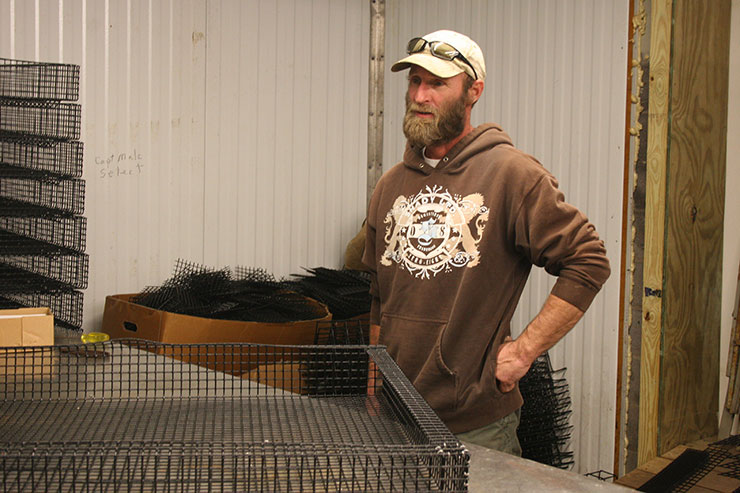
Asked what his oysters taste like, Daniels doesn’t even have to think.
“Mine are the best in the world,” he responds without hesitation. Then he laughs. “That’s what they all say. That’s what they’re supposed to say.”
But then he gets serious. “I think oysters taste like the last thing they drank,” he says.
Harvest conditions, such as tides and rain, can affect their “I grew up in this town right here and the fish houses are closing,” he says, noting that his community is always on his mind. “The inlet’s closed half the time so the big boats can’t come and go. And those people need jobs, so we’ve got to bring some product across those docks to keep things going.”
Daniels has big plans for his oyster farm. “We’re trying to do it on an industrial scale. I don’t think anyone’s tried to do that in our state yet,” he continues. “I don’t claim to be doing that yet but that’s what our goal is. I feel like it’s our future. We need to do it.”
North Carolina has the second largest estuarine system in the country but produces less than 1 percent of cultured oysters in the U.S., Daniels observes. He wants to see the state’s growers become key players in that market. “It’s time for us to get in the game.”
Finding a Niche
Matteo, who owns Chadwick Creek Oysters in Bayboro, wants to help change things where he is too. And he is throwing himself right into the job.
The coastal property he purchased came with an 8-acre shellfish franchise — a deeded claim to submerged land on which the owner pays taxes. The state no longer issues franchises.
Instead it offers bottom or water-column leases on five-year contracts.
His franchise, 25 miles east of New Bern, is close to Swan Quarter and Pamlico Bay, areas that once were rich in oysters. However, Matteo and wife Kelly found that many of those operations had been shuttered. The couple also noticed that most oysters consumed in North Carolina were not local, which didn’t make sense to them, given the state’s vast water resources. “We figured that if we could help turn the tide, we would love to get involved and do that,” Matteo says.
Then last spring, Matteo, along with father-in-law Duane Creech and Doug Cross from Pamlico Packing, went to visit several oyster aquaculture businesses in Maryland and Virginia, and the oyster hatchery at the Virginia Institute of Marine Science — a tour organized by Turano.
The trip was a tipping point. It made Matteo want to pursue oyster aquaculture in a way that would be more than a “weekend warrior” effort. He wanted this venture to be more than a side interest.
And so he jumped in, literally and figuratively. Immediately after that trip, Matteo and Creech were up to their chests in 4 feet of water in Chadwick Creek, planting oyster seed. That was early April. Seven months later, they were harvesting their first legal-sized oysters. In the world of oyster growing, this is fast.
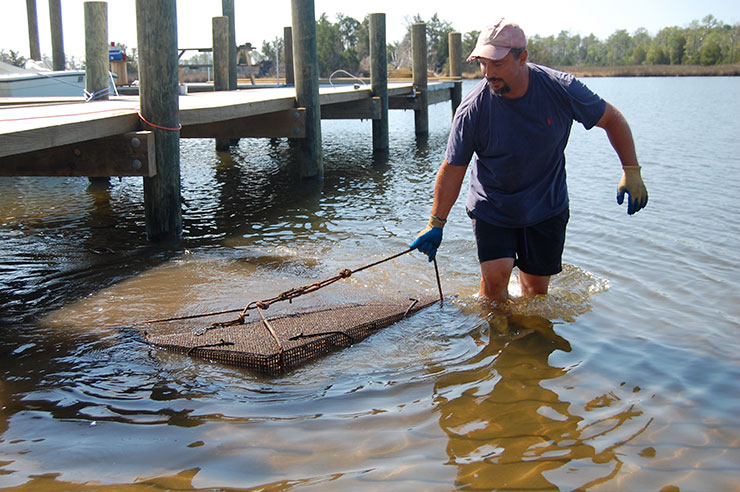
Matteo is still ironing out the details. He wants to get the process optimized, efficient and simplified to the point where he can “basically hand it off to someone who hasn’t spent the last year doing this and they could easily pick it up and run with it,” he notes. He wants to focus on the business and marketing aspect of the venture.
Currently, he takes his oysters to Cross at Pamlico Packing in Grantsboro, about 15 minutes away. Cross’ trucks deliver his product to Locals Seafood in Raleigh, for distribution to individuals and restaurants.
“They are some of the best oysters we have eaten. Delicious on the half-shell, their deep cup and subtle brine are perfect for my tastes,” says Lin Peterson, co-owner of Locals Seafood.
“It’s great to offer a premium oyster, grown and harvested year-round in North Carolina waters.” Local restaurants give a “thumbs up” to these oysters, Peterson adds.
“Our priority is to sell a local product in a local way,” Matteo says. His goal is to produce enough oysters to satisfy in-state demand. Then he wants to venture into neighboring states, such as Virginia and Maryland, and reverse North Carolina’s oyster-importing trend.
Matteo says his oysters are unique. “We have a very distinct oyster in North Carolina,” he explains. “We’re the only grower right now on the lower end of the salinity scale.”
In addition, the salinity of his oysters can vary slightly from week to week. “We’re in a wind-tide area, so if the wind blows a certain way, the oysters are saltier and if it blows a different way, it’s lower salinity,” he says.
In preparation for spring growing season, Matteo has put more seed in the water and plans to expand his venture once the water starts to warm up. But he’s satisfied for now.
“So far, so good. We’ve put a lot of effort into it. We’ve put a lot of money into it,” he says, with a wry laugh. He understands that operations such as his take time to hit their stride. However, he is glad to be in a business that speaks to something near and dear to his palate and plate.
“My wife and I are foodies at heart so we wanted to get involved in something that generated a local product,” he explains.
Creating a Welcoming Place
These cultured oysters benefit people, as well as the surrounding environment and the creatures that live in their vicinity. If these shellfish spawn, they replenish the wild population in the area. And when they die, their shells provide new surfaces upon which spat can settle.
“Increasing the population of oysters has dual benefit. In addition to being a tasty seafood option, oysters provide many ecosystem services including filtering the water and providing habitat to a multitude of marine species,” says John Fear, Sea Grant deputy director.
Mainly, oysters filter the water, removing impurities, and often extracting particles that prevent sunlight from reaching the bottom. Increased sunlight encourages the growth of submerged aquatic vegetation, which provides habitat for many juvenile species — such as crabs, flounder and shrimp — that form the backbone of the state’s commercial fisheries.
So these bivalves, and the aquaculture operations that are growing them, are giving back to the state’s economy and environment in incalculable ways.
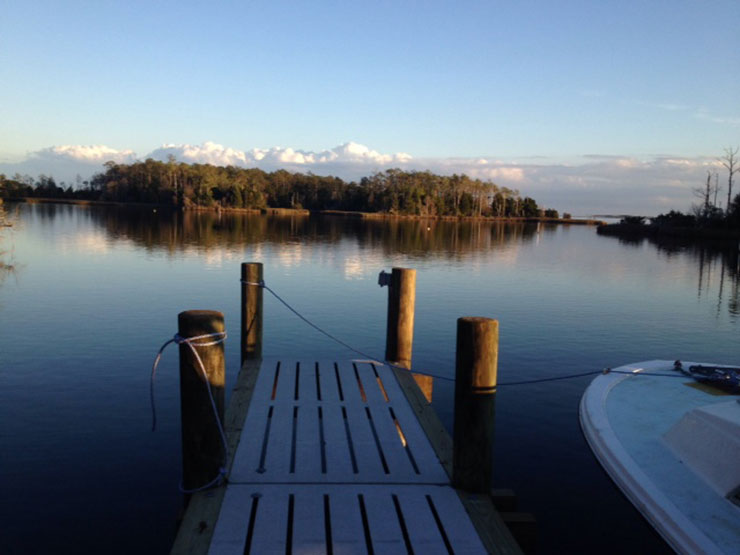
“It’s one of the few businesses that you can get into where it’s a win-win-win. It’s a win for the end consumer — they get a fresh, healthy product,” Matteo explains. “And at the same time, it’s awesome for the environment,” and lucrative for the grower.
He uses two kinds of oysters: triploids that cannot spawn and diploids that can reproduce. Growers prefer the triploid because it does not expend energy on reproduction, meaning that its flesh is consistently firm and juicy. During spawning season, diploids often have lower-quality meat because their energies are redirected toward propagating.
But both kinds of shellfish benefit the environment, Matteo explains. Diploids spawn and replenish the wild oyster stock in the area. Triploids, even though they don’t add to the local population, filter the surrounding water.
“And there aren’t too many businesses or crops that you can grow that leave the environment in a better state than it was prior,” he adds.
Daniels, who uses triploids exclusively, emphasizes the benefits from his oysters beyond filtering.
“Every one that dies out here, there’s another shell in the water,” he says. “Wild spat can come and attach themselves to those shells, and now you’ve got wild oysters. So you are helping. Even though my oysters aren’t going to spawn, a good portion of them die, so I’m putting shell on the bottom to build natural oyster reefs.
“When I lose, nature wins. So it’s a good thing either way you look at it.”
Learn about these and other aquaculture operations at the N.C. Aquaculture Development Conference in February. Go to page 4 for details. Find Chadwick Creek Oysters at chadwickcreek.com.
This article was published in the Winter 2014 issue of Coastwatch.
For contact information and reprint requests, visit ncseagrant.ncsu.edu/coastwatch/contact/.
